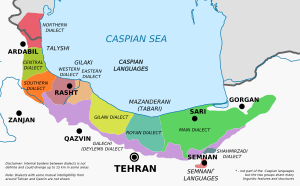Semnani languages
| Semnani | |
|---|---|
| Geographic distribution | Iran |
| Linguistic classification | Indo-European |
| Subdivisions | |
| Glottolog | semn1240[1] |
 Caspian and Semnani languages (lower right) | |
The Semnani languages are a group of Northwestern Iranian languages,[2] spoken in Semnan province of Iran that share many linguistic features and structures with Caspian languages. These languages are also called "dialects" in some sources.[3]
There are six Semnani languages named in the literature. Some may be dialects, but there is little published work on their relationships.[4]
Cognate sets[5]
| English | Sorkhei | Lasgerdi | Sangsari | Aftari | Biyabunaki |
|---|---|---|---|---|---|
| dog | esbā | esbe | esbe | espa | esba |
| girl | dukkey | dot | döt | dut | dut |
| blood | xün | xün | |||
| large | masīn | masīn | mas/yale | masīn | |
| nose | ven | vinī | xunī | vinī | vēnī |
| snow | vār | var | varf | var | |
| serpent | mohur | mahar | |||
| moon | mūng | māye | |||
| woman | žiki | žaki | žekeyn | džek | džinakā |
Notes
- ↑ Hammarström, Harald; Forkel, Robert; Haspelmath, Martin, eds. (2017). "Semnanic". Glottolog 3.0. Jena, Germany: Max Planck Institute for the Science of Human History.
- ↑ Ethnologue lising for Semnani languages
- ↑ Lecoq, pg. 297
- ↑ C.F. & F.M. Voegelin, Classification and Index of the World's Languages (1977) lists them as dialects of Persian (pg. 185).
Lecoq, pg. 297 lists them as "dialects" as well.
Ethnologue lists Semnani, Sorkhei, Lasgerdi, and Sangsari as languages with Biyabunaki as a possible dialect of Semnani and Aftari as a dialect of Sorkhei.
Linguasphere lists them together in an outer language called Semnani+Sangisari [58-AAC-f] with Semnani and Sangisari listed as inner languages.
Merritt Ruhlen, A Guide to the World's Languages, Volume 1: Classification (1991) lists Semnani and Sangisari as languages in the Semnani subgroup. - ↑ Lecoq, pg. 310.
Bibliography
- Pierre Lecoq. 1989. "Les dialectes caspiens et les dialectes du nord-ouest de l'Iran," Compendium Linguarum Iranicarum. Ed. Rüdiger Schmitt. Wiesbaden: Dr. Ludwig Reichert Verlag. Pages 296-314.
- Habib Borjian. 2008. “The Komisenian Dialect of Aftar,” Archiv Orientální 76: 379-416.
This article is issued from
Wikipedia.
The text is licensed under Creative Commons - Attribution - Sharealike.
Additional terms may apply for the media files.